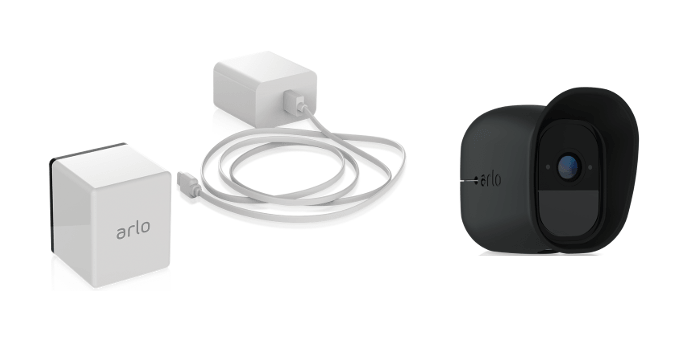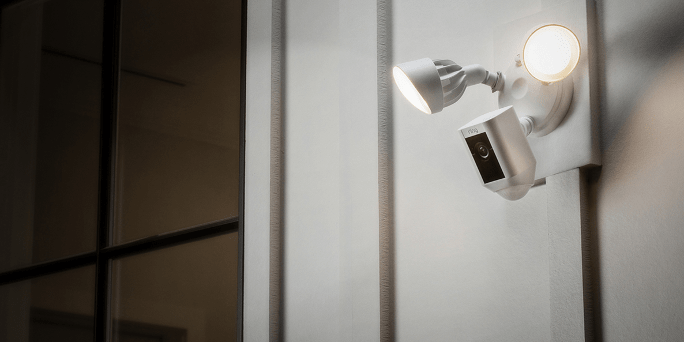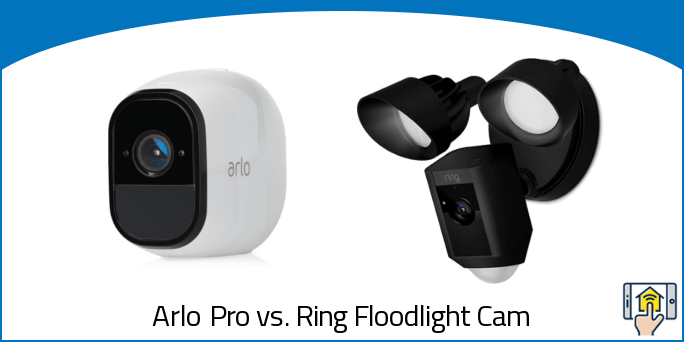Arlo has been on the market for a while now, and their products are some of the top performers in the smart camera scene. Ring made their name with excellent video doorbells, before coming onto the market with an excellent line of cameras that hold their own as well. When comparing Arlo Pro vs. Ring Floodlight, we do feel like Ring is the better option.
While the Arlo Pro offers a lot of flexibility in placement in installation because of its battery power, the Ring offers a lot of superior features like better video quality, better motion detection, a better field of view, and more. Both options are a good choice, but we don’t think it’s any secret that the Ring Floodlight has a bit of an advantage.
Below we go into detail on the similarities and differences of the Arlo Pro vs. Ring Floodlight Cam. Read on for the full picture, or use our navigation bar to jump right down to the sections that interest you most.
Arlo Pro vs. Ring Floodlight Cam — Things in Common
Two-Way Audio – two-way audio comes standard on both devices, which allow you to both listen in on the activity and communicate with intruders or guests. While our regular use would probably trend more towards keeping pets off the furniture than scaring off a thief, it’s a nice feature to have on hand in a pinch.
WiFi – Both devices run off of 2.4GHz WiFi only, which can potentially cause some issues if you have a lot of cameras as they can start to eat up bandwidth. If you’re looking for a dual-band option that uses a 5GHz frequency as well, Ring has you covered with the Ring Stick Up Cam Elite.
App Support – Checking in on your home security has never been easier, with an Android, iOS, and Web app for both brands.
Live View – You can view your video’s feed at any time through the app or web using the On-Demand Live view, and both Arlo and Ring offer the option to record that view as well. Just keep in mind that if you opt for Ring, you’ll have to pay a $3 per month subscription, while the feature is available for free with Arlo.
Zoom – Regardless of your choice in brand, you’ll never have to worry about missing action in the distance due to the useful digital zoom feature.
Weather-resistant – While a lot of cameras are designed either to be used indoors or to be used outside, the Arlo Pro and Ring Floodlight Cam work equally well in both applications due to their weather-resistance.
IFTTT & Stringify – One of the best ways to connect your smart home devices together are platforms like IFTTT and Stringify. These utilities allow you to do things like flashlights when motion is detected, or pretty much anything else you can think of due to their “trigger” system that can allow your cameras to start another action or be activated by other smart tech. Both Arlo and Ring function quite well with both of these systems.
Arlo Pro vs. Ring Floodlight Cam — Differences

Difference #1: Video Quality – The first difference in our list when comparing Arlo Pro vs. Ring Floodlight Cam is video quality. Having a camera recording doesn’t mean much if the feed is a blurry mess, and both cameras do a pretty good job of providing a high quality stream.
However, while Arlo Pro has a 720p quality, Ring Floodlight Cam is much more impressive with full 1080p HD. This difference in quality can be the difference between being able to get a clear picture of an intruder’s face, and having their identity lost in the midst of the action. This is one of the biggest advantages that Ring has over Arlo, since the quality of your camera’s video feed is pretty much the core of how well you can monitor your home.
Both cameras do record in 30FPS, however, and also have H.264 video compression that should allow the average home network to support 3 or 4 cameras without putting much of a strain on the available bandwidth.
Difference #2: Field of View – Field of View is especially important when monitoring the outside of your home, as it can give you a fuller picture of your yard rather than a narrow view of a specific area. It’s also useful indoors, depending on the size of the room and where you place the camera.
The Arlo Pro falls a little short here with a 130 degree field of view, while the Ring Floodlight Cam is a little stronger at 140. This isn’t a significant difference, but it does mean you’ll get a more comprehensive picture on your video feed.
Difference #3: Power Options – Arlo Pro offers flexible placement with a rechargeable battery that will last 3-6 months on a single charge. You can also purchase a Solar Panel so that the battery lasts indefinitely, or bypass the battery completely by powering the camera using an AC plug.
The Ring Floodlight Cam only works with hardwired 110-240 VAC power. This makes installation a little bit more difficult, but it’s a more reliable power source overall — especially when compared to battery.
Ultimately, we feel that the Ring Floodlight Cam is a little more reliable, but it does require a little bit of handiness or professional installation to get things up and running. You really can’t beat the flexibility of the Arlo Pro’s battery power, but the lower voltage does mean that you’ll be missing out on some useful features.
Difference #4: Motion Detection – The Arlo Pro’s motion detective is pretty basic by default, with no motion zones available. However, with an Arlo Smart subscription, you can take advantage of Cloud Activity Zones that allow you to customize the areas that your camera detects motion — significantly cutting down on false alarm. Arlo Smart also adds in person detection, which helps the camera do a better job of detecting whether motion is worth recording.
The Ring Floodlight Cam’s motion detection is more advanced. It uses the camera itself to detect motion, and can use “human detection” technology to stop false alerts by using a combination of face and body-shape analysis. Motion zones are available by default, so you can define specific areas for your camera to cover while ignoring specific high traffic areas like public paths or streets.
Ring’s battery-powered cams use passive infrared sensors in order to detect motion by heat signatures, and the Floodlight Cam actually takes advantage of this technology as well — using it in combination with its camera-based detection to provide more comprehensive coverage.
All in all, the Ring Floodlight Cam’s motion detection is better by a large margin, with more advanced technology and all of its features enabled by default rather than locked behind a subscription.
Difference #5: Night Vision – Both cameras feature night vision, but the Arlo Pro’s vision is only in Black and White while Ring Floodlight Cam has “enhanced” night vision with full color. The color can make it a lot easier to get a detailed picture of trespassers, so the enhancement does a lot more than make for a prettier video feed.
Difference #6: Requires a Base Station – The Arlo Pro, like the original Arlo and the Arlo Pro 2, requires a base station in order to function. This piece of equipment comes with the camera by default so you won’t have to worry about an extra purchase, but it takes up space by your router and requires an ethernet connection. The base station does add in some extra features like local storage, a siren, and the increase range and battery life, but we find it overall pretty inconvenient. You can add in up to 15 cameras to one Arlo Base station, but if you’d like to expand beyond that, you’ll need a second. Check out our take on Arlo vs. Arlo Pro Base Station if you’d like an idea of what options are out there if you do decide to expand.
The Ring Floodlight Cam functions as is without any need for a base station, which makes getting things set up a little bit easier. You also won’t have to worry about purchasing extra equipment either if you have a larger house and want to add in a bunch of extra cameras.
Ultimately, the features added in by the base station are convenient, but we find ourselves valuing the simplicity of the Ring Floodlight Cam.
Difference #7: Siren – While monitoring your home with cameras is great for security as is, it’s important to be able to sound the alarm in the event of an actual emergency. You could handle that through a full security system like the Ring Alarm, but both of these cameras also have a siren as well.
The main difference between the two brands when it comes to the siren is that with the Arlo Pro, it’s built into the base station, while the Ring Floodlight Cam has a 110dB siren built into the camera itself.
There are advantages and disadvantages to both setups. Having the camera directly on the camera makes it easy for your neighbors to hear the commotion and come to your aid, but they can also attract the attention of intruders who could potentially damage your equipment. The Arlo Pro’s base station keeps the siren more secure, but it’s a little bit less noticeable since it will be concentrated near your router rather than spread out in each camera.
Which setup is better is really going to depend on what you value more: a louder and easier-to-hear siren, or protecting your camera.
Difference #8: Local Backup Storage – The Arlo Pro’s base station might be a little bit inconvenient, but it does add in some cool features like local backup storage. You’ll still need to use the cloud storage as the default, but local storage on a USB in the base is great to have as a backup in the event of your internet connection going down. The Arlo app will also let you know when the local storage is starting to get full, and can even record over the older footage when it reaches maximum capacity so you don’t really have to deal with it unless you need it.
The Ring Floodlight Cam, unfortunately, does not have access to local storage. If your network connection drops, you won’t have access to any recording features.
Difference #9: Subscription – The Arlo and Ring cameras both have their own subscriptions, but there are some pretty significant differences in the way that they work.
We’ll kick things off by talking about Ring, since they are the easiest to understand. There are two main plans: Ring Protect Basic, and Ring Protect Plus.
Ring Protect Basic costs $3 per camera monthly, and enables on-demand video recording as well as storage for up to 60 days. Ring Protect Plus costs $9.99 per month, and allows recording and storage for as many cameras you please, as well as 24/7 monitoring if you do opt for the full Ring Alarm security system.
Arlo Pro’s subscription plan is called Arlo Smart, and there are four different plans Arlo Smart Basic, Add-on, Premier, and Elite.
Arlo Smart Basic is free and includes 7 days of cloud recordings and support for up to 5 Arlo cameras.
Arlo Smart Add-on is when you start to get additional features. This costs $2.99 per camera monthly, and adds in a number of different features. You’ll still have the same capacity for recordings and cameras, but you’ll enable some extra motion detection features like person detection and cloud activity zones. Furthermore, you’ll also have access to Rich Notifications which allow you to call for help or sound the alarm directly from the notification itself rather than having to unlock your phone and open the app, as well as e911 Emergency Call Service that can send help directly to your home in the event of an emergency rather than your current location.
Arlo Smart Premier and Smart Elite have the same features as the add-on, but they expand your capacity for recordings and allow you to add in more cameras to your system. Premier costs $9.99 per month, and allows for 30 days of recordings as well as 10 Arlo cameras, and Elite costs $14.99 and allows for 60 days of recordings and 20 Arlo cameras.
Ultimately, we feel that Ring is the better deal financially if you have a lot of cameras since a flat $9.99 fee gives you access to recording and storage for unlimited cameras. Arlo is a little bit more expensive for the higher tier plans, but their subscription does include access to useful utility features like Rich Notifications and e911 Emergency Call Service.
Difference #10: LED Lights – The Ring Floodlight, as the name suggests, has a light built in that is perfect for keeping an eye on your yard. Plus, it’s extremely bright at 1800 lumens.
The Arlo Pro requires that you purchase the Arlo Security Light separately, which is an additional expense you’ll have to worry about if you want that illumination. And as far as brightness goes, it’s a lot dimmer at 400 Lumens.
There’s no question: the Ring Floodlight has a much better floodlight (who would have thought?)
Difference #11: Voice Control – Both cameras work quite well with Amazon Alexa, and pair great with Echo Show or Echo Spot since you can watch your video feed right on the screen. One thing to keep in mind, however, is that two-way audio doesn’t work on the Echo Show — you’ll just be able to listen, not speak.
Arlo Pro is alone in its support for Google Assistant, which isn’t exactly surprising considering that Ring is owned by Amazon. Regardless of the reasoning, we’re a little disappointed that Ring is more restrictive while Arlo supports both of the major voice assistants.
Difference #12: Operating Temperature – Both cameras are weather resistant, but those in homes with extreme cold or heat will be better suited with the Ring Floodlight Cam’s -22°F to 120°F operating temperature. The Arlo Pro is still pretty hardy, but it falls short with a range of 4° to 113° F.
Arlo Pro vs. Ring Floodlight Cam — Comparison Chart
| Arlo Pro | Ring Floodlight | |
|---|---|---|
| Video resolution | 1280 x 720p | 1080p HD |
| Frames per Second | 30 FPS | 30 FPS |
| Video Format | H.264 | H.264 |
| On-Demand Live View | Yes | Yes |
| Record Live View | Yes | Subscription Required |
| Field of View | 130° | 140° |
| Zoom | 8x digital zoom | Yes |
| Power | Rechargeable Battery/AC | Hardwired 110-240 VAC |
| Optional Power Source | Solar Panel | N/A |
| Battery Life | Battery: 3-6 months Solar: indefinitely | N/A |
| Two-Way Audio | Yes | Yes |
| Motion Detection | Up to 23 feet | Advanced |
| Motion Zones | No | Custom, up to 6 |
| Person Detection | With Subscription | Yes |
| Facial Recognition | No | No |
| Sound Detection | Yes | Yes |
| Night Vision | 850 nm LEDs: illuminates up to 25 feet IR cut-off filter | Yes (enhanced coming) |
| WiFi | 2.4 GHz | 2.4 GHz |
| Requires a Base Station | Yes | No |
| Max # of Cameras per Base Station | 15 | – |
| Siren | Via the Base | 110 dB built-into camera |
| 24/7 Recording | No | No |
| Local Backup Storage | Via the Base | No |
| Cloud Storage | 7-Day Free / Subscription | Subscription Required |
| Review, Share, & Save | Yes | Subscription Required |
| e911 Emergency Call | With Subscription | No |
| Instant App Alerts | Yes | Yes |
| App Support | Android, iOS, Web | Android, iOS, Web |
| Rich Notifications | With Subscription | No |
| Weather-resistant | IP65 rating | Yes |
| LED Lights | Sold Separately 400Lm | Built-in floodlights 1,800Lm. |
| Amazon Alexa | Echo Show, Echo Spot | Echo Show, Echo Spot |
| Google Assistant | Yes | No |
| IFTTT | Yes | Yes |
| Stringify | Yes | Yes |
| Operating Temperature | -4° to 113° F | -22°F to 120°F |
| Dimension | 3.1 x 1.9 x 2.8 in | Base: 4.75 inch diameter |
| Color | White | Black/White |
Arlo Pro vs. Ring Floodlight Cam — Accessories

As far as accessories go, the only thing you might want to consider with the Ring Floodlight is Ring Camera Installation. The hardwiring can be a little challenging for those who aren’t particularly handy, so it’s nice to have some help from Amazon on hand. Just keep in mind that you’ll need existing wiring available, as the Amazon tech isn’t equipped to do the work of an electrician.
The Arlo Pro has a few more accessories available, such as the Solar Panel and extra rechargeable battery if you decide on battery power rather than the AC plug. There’s also the Arlo Security Light to add some illumination, as well as the Arlo Pro Skins to help disguise your camera from intruders.
Arlo Pro vs. Ring Floodlight Cam — Our Thoughts

All in all, we feel that the winner of this Arlo Pro vs. Ring Floodlight Cam comparison is clear. Ring just offers too many advantages to give Arlo the crown.
From the better video quality and motion detection, to the much stronger flood light and night vision, it’s overall a better camera by pretty much every metric. Also, with the Ring Plus subscription plan, you can have 24/7 professional monitoring with Ring Alarm as well as support for as many cameras as you please. Check out our take on Ring Alarm Review — Things You Should Know for more information.
The Arlo Pro camera does have its advantages like local storage and more flexible installation, but overall we feel like it has a bit of an issue standing on equal footing with Ring.
For more information about floodlight cameras, check out our detailed comparison:
Last update on 2024-04-23 at 07:19 / Affiliate links / Images from Amazon Product Advertising API









